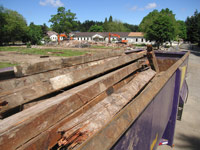Construction and demolition debris recycling and diversion
Things to keep in mind regarding construction and demolition (C&D) debris recycling:
- Recyclable construction materials can be source-separated on site or commingled and hauled off site to a sorting facility for separation and recycling. While source separation is generally preferable to commingling, there are pros and cons to both methods.
- Both the Built Green™ and LEED™ green building programs award builders who achieve at least a 50 percent recycling rate on their projects.
- Recycling rates reported for Built Green™ and LEED™ certification should be based on the monthly Appropriate for Processing recycling rate at the facility where the material is taken. Note that all tip receipts must be retained and must show that the material was accepted for recycling (not as C&D waste).
- Facilities and hauling companies which accept C&D material for recycling are listed on the What do I do with…? website.
- Recycling rates for facilities which process commingled C&D materials for recycling are listed below.

Pros and cons of separating C&D
Source separation
The source-separation of C&D materials on site for recycling is generally more cost-effective than disposal or commingled recycling and yields an average facility recycling rate of 90+ percent. Source-separation also helps create higher-end markets for recyclables, such as the manufacture of new recycled-content building materials.
Commingled recycling
On jobsites where space is limited, having fewer recycling containers on site and commingling the recyclables can save valuable space. The recycling rate of commingled programs, however, has proved to be significantly lower than that of source-separation programs. In commingled programs, materials that have the potential to be recycled, such as drywall, carpet and ceiling tiles, are disposed of as garbage. The only way to quantify the amount of commingled materials recycled on a particular project is to use the facility's recycling rate.
To learn more about your options for disposing of C&D materials or for assistance on setting up a successful diversion/recycling program, contact the Construction Recycling program online.


 Translate
Translate
